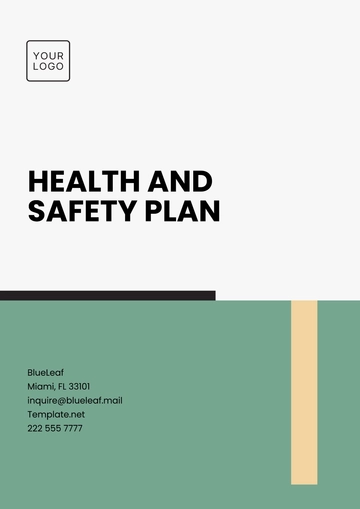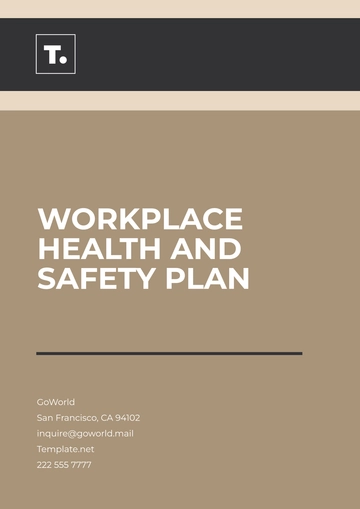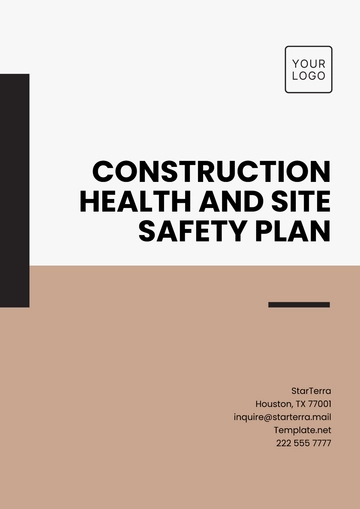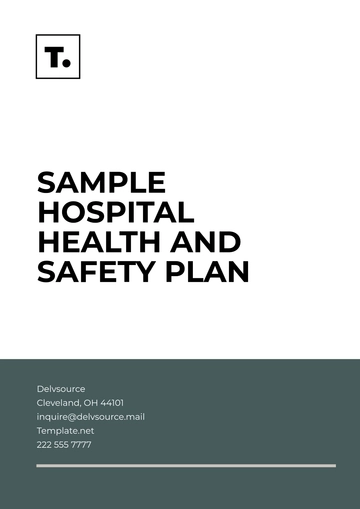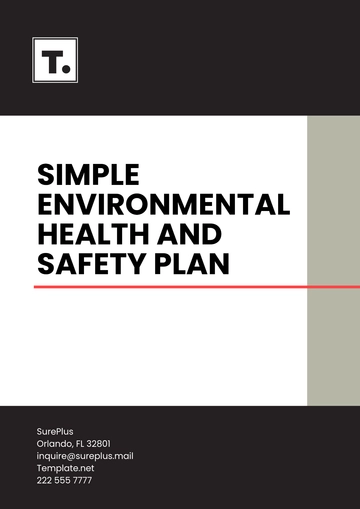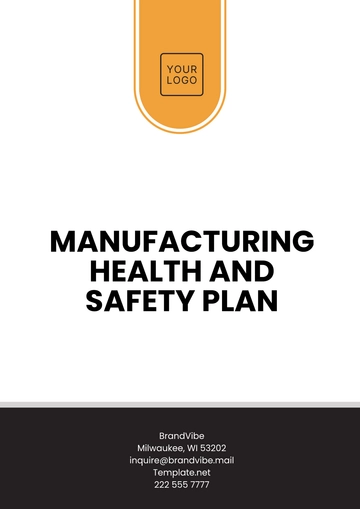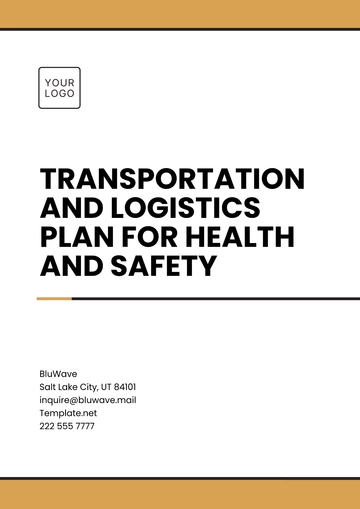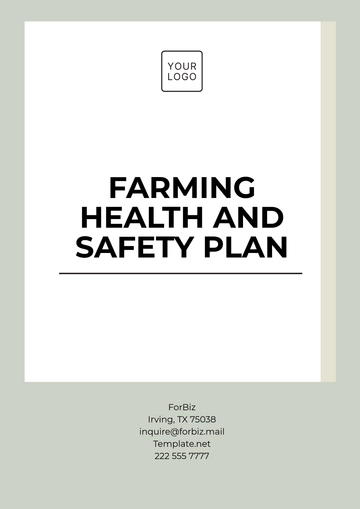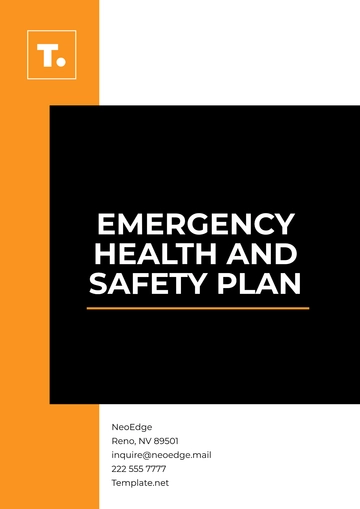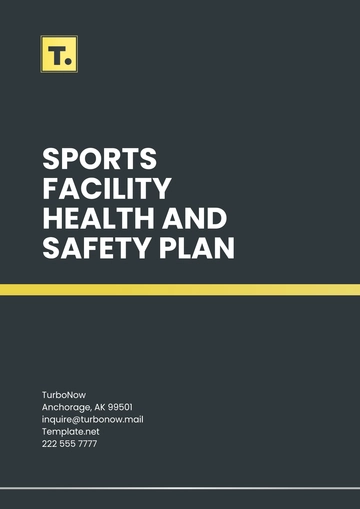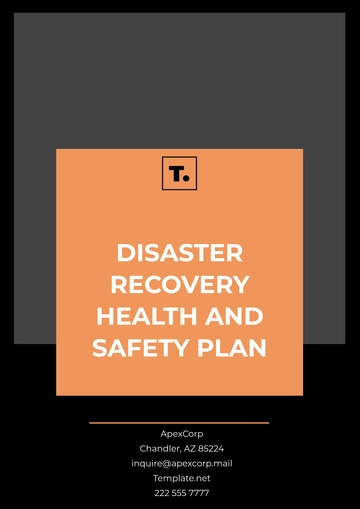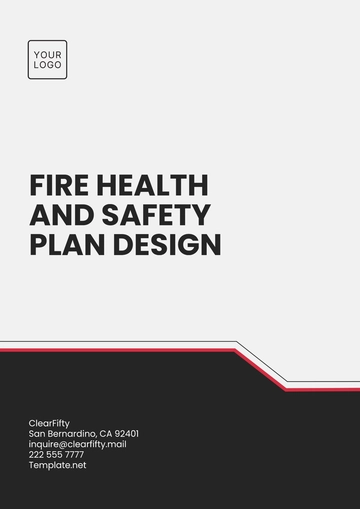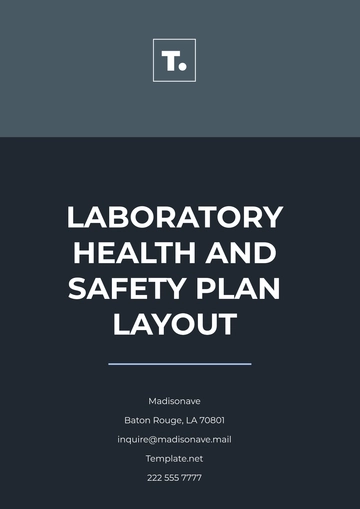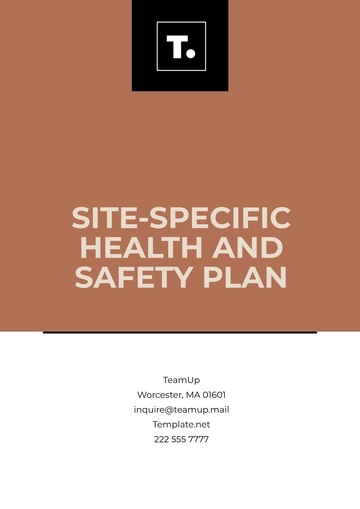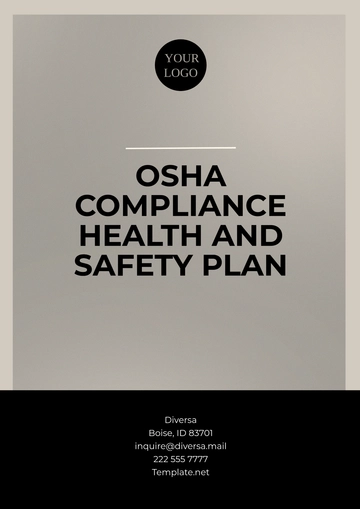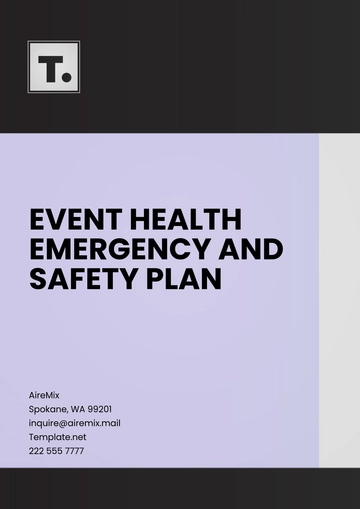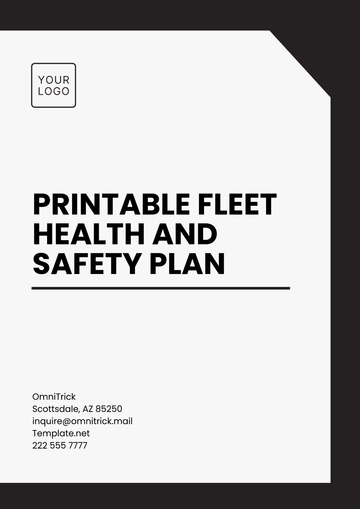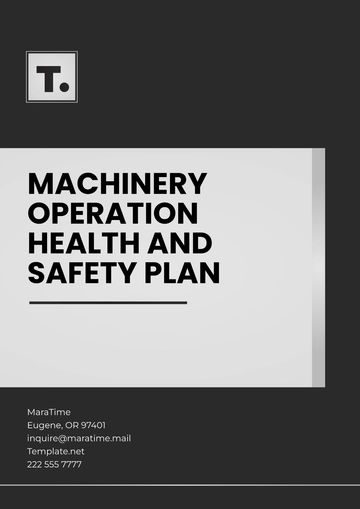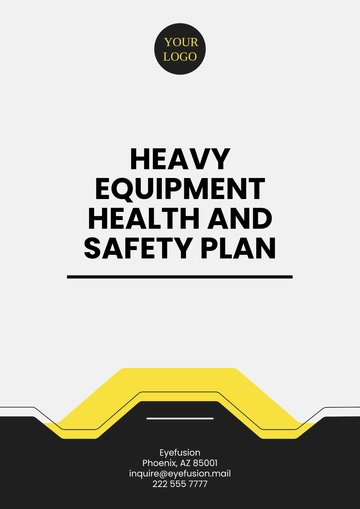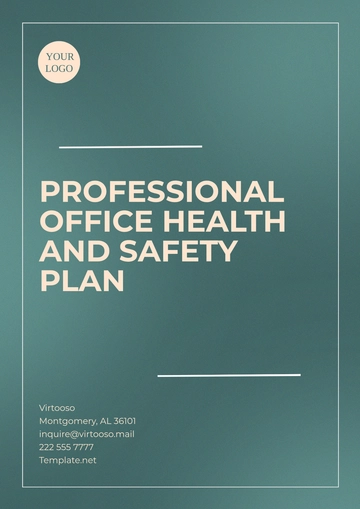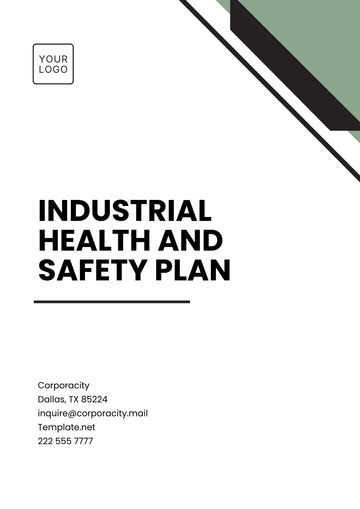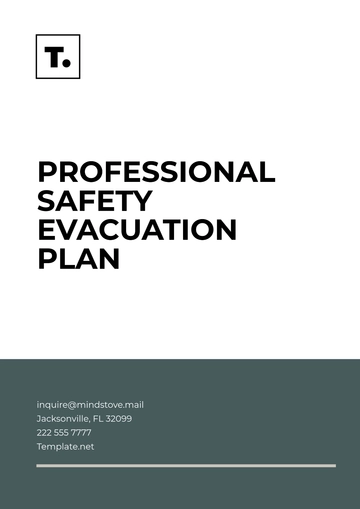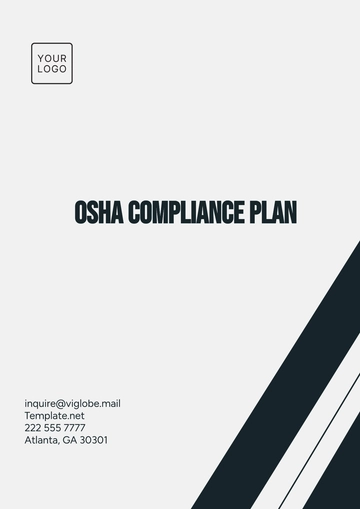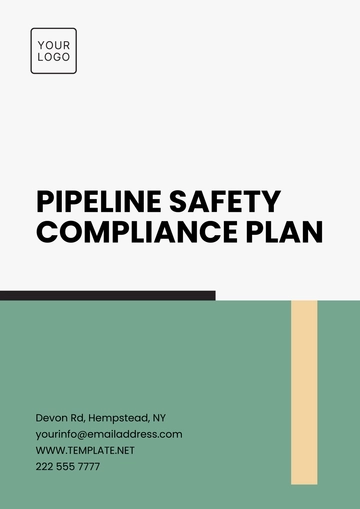Free Health & Safety Training Plan Document
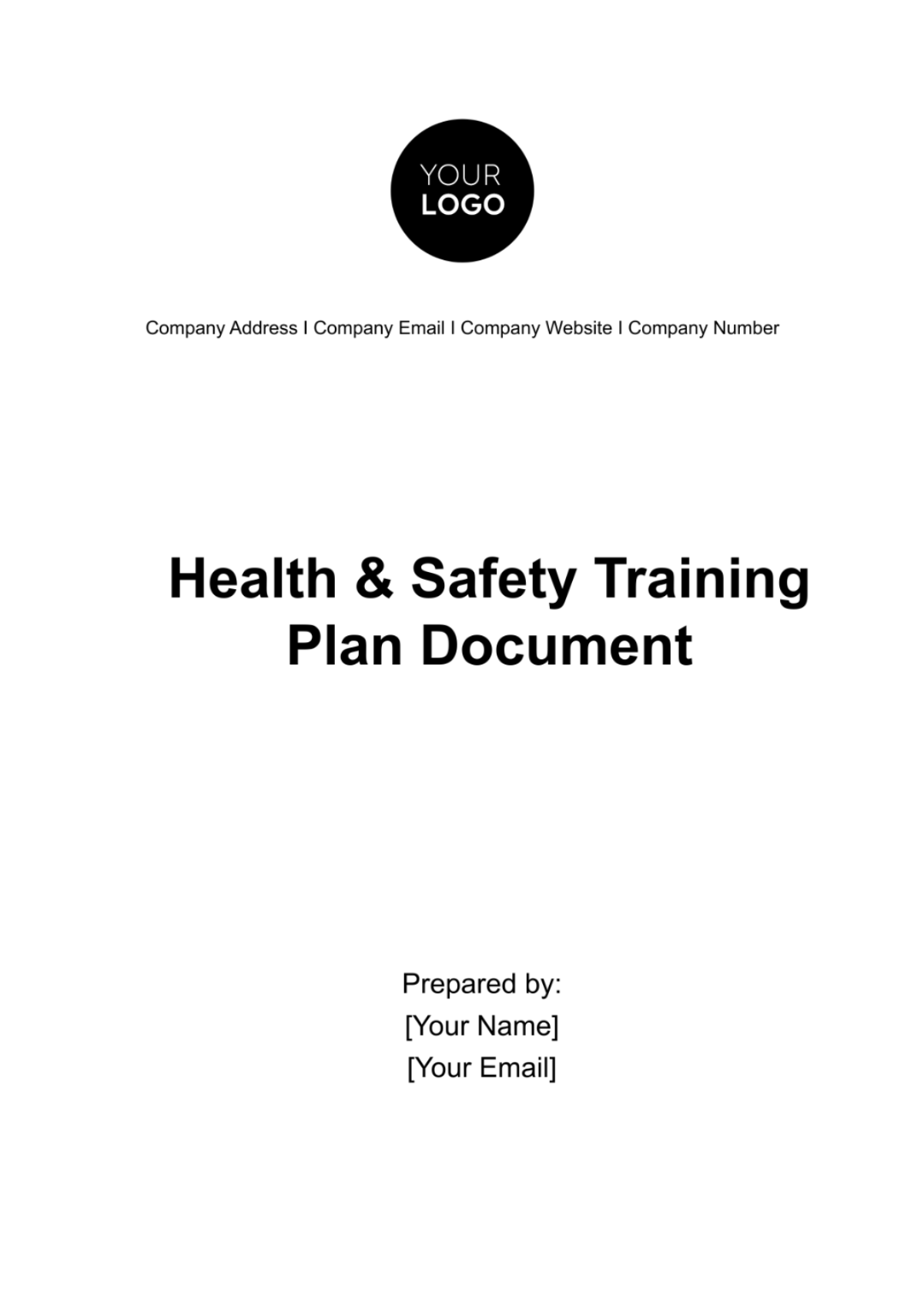
Introduction
A. Purpose
The purpose of this comprehensive Health & Safety Training Plan is to create a culture of safety at [Your Company Name] and ensure the physical well-being and security of all employees. It aims to minimize workplace accidents, injuries, and illnesses by providing structured and effective training programs.
B. Scope
This Health & Safety Training Plan covers all employees, contractors, and visitors associated with [Your Company Name]. It encompasses various aspects of health and safety training, including hazard identification, emergency response, and safety protocols.
C. Objectives
The objectives of this plan are as follows:
Ensure Compliance: Ensure that [Your Company Name] complies with all relevant federal, state, and local health and safety regulations.
Reduce Risks: Identify and mitigate potential workplace hazards, reducing the risk of accidents and injuries.
Empower Employees: Equip employees with the knowledge and skills necessary to work safely and make informed decisions regarding health and safety.
Promote Accountability: Foster a sense of responsibility among all employees for their own safety and the safety of their colleagues.
Continuous Improvement: Establish a framework for continuous improvement by regularly evaluating and updating the training program.
Responsibilities
A. [Your Company Name]
[Your Company Name] assumes the primary responsibility for the successful implementation of this Health & Safety Training Plan. Key responsibilities include:
Development and Implementation: Develop, maintain, and implement the training program in accordance with regulatory requirements.
Resource Allocation: Allocate resources, including personnel and funding, to support training activities.
Regulatory Compliance: Ensure that all training activities comply with relevant health and safety regulations.
Monitoring and Reporting: Monitor the effectiveness of the training program and provide regular reports to senior management.
B. Employees
Employees at [Your Company Name] have essential roles and responsibilities in the context of health and safety training:
Participation: Actively participate in all mandatory health and safety training sessions and follow safety procedures.
Reporting: Report any safety concerns, incidents, or hazards promptly to their supervisors or the designated safety officer.
Accountability: Take responsibility for their own safety and the safety of their colleagues by following established safety guidelines and protocols.
C. Trainers
Trainers play a critical role in delivering effective health and safety training. Their responsibilities include:
Qualifications: Possess relevant qualifications and experience in health and safety training.
Delivery: Deliver training sessions effectively, using engaging methods and practical exercises.
Materials: Ensure that training materials are up-to-date and aligned with current best practices.
Evaluation: Continuously assess the progress and understanding of trainees and provide feedback for improvement.
Training Needs Assessment
A. Hazard Identification
A thorough assessment of workplace hazards is critical to ensure the safety of all employees. This process involves:
Hazard Identification Process
Survey and Inspections: Regular surveys and inspections of the workplace will be conducted by qualified safety personnel.
Employee Input: Employees are encouraged to report potential hazards or unsafe conditions they encounter.
Incident Analysis: Historical incident data will be analyzed to identify recurring patterns and potential areas of concern.
Regulatory Compliance: Regular checks will be carried out to ensure that the workplace complies with all relevant safety regulations.
Continuous Monitoring: Ongoing monitoring will be established to detect new or evolving hazards.
B. Skill Gaps Analysis
To effectively address skill gaps, [Your Company Name] will perform a comprehensive analysis:
Skill Gaps Analysis Process
Employee Skill Assessment: Employees will undergo skill assessment tests related to their specific job roles.
Performance Reviews: Performance reviews will be conducted to identify areas where additional training is required.
Feedback Mechanism: An open feedback mechanism will be established for employees to express their concerns or training needs.
Benchmarking: Comparison with industry standards and best practices will be used to identify areas where improvements are needed.
Regular Updates: Skill gap analysis will be an ongoing process to adapt to changing roles and responsibilities.
Training Program
A. Training Topics
The training program at [Your Company Name] will encompass a wide range of topics, tailored to specific job roles and workplace hazards:
Sample Training Topics
Workplace Safety: Covering general safety protocols, emergency procedures, and incident reporting.
Hazard Recognition: Teaching employees to identify potential hazards in their work environment.
First Aid and CPR: Providing essential skills for responding to medical emergencies.
Fire Safety: Training on fire prevention, evacuation procedures, and fire extinguisher use.
Equipment Operation: Ensuring employees are competent in operating machinery and equipment safely.
B. Training Methods
To effectively deliver training, a variety of methods will be employed:
Training Methods
Classroom Training: Instructor-led sessions covering theoretical aspects of safety.
Hands-on Training: Practical demonstrations and simulations to develop practical skills.
E-learning Modules: Online courses accessible for self-paced learning.
Workshops and Drills: Interactive sessions and emergency drills to reinforce learning.
Mentoring: Experienced employees mentoring newcomers to ensure on-the-job safety.
C. Training Schedule
A well-structured training schedule will be developed and communicated to all employees:
Sample Training Schedule
Orientation: New employees receive safety orientation within the first week.
Monthly Safety Meetings: Regular safety meetings for updates and refresher training.
Quarterly Drills: Fire drills and emergency response exercises held every quarter.
Annual Recertification: Annual recertification for specific skills such as CPR or equipment operation.
Training Materials and Resources
Learning Materials
High-quality learning materials are essential for effective training. [Your Company Name] will provide a range of resources, including:
Learning Materials
Training Manuals: Comprehensive manuals covering safety protocols, emergency procedures, and equipment operation.
Videos and Demonstrations: Visual aids and video tutorials to enhance understanding.
Interactive E-Learning Modules: Online courses accessible anytime, anywhere.
Safety Posters and Infographics: Visual reminders of key safety principles placed throughout the workplace.
Reference Guides: Quick-reference guides for immediate assistance during emergencies.
These materials will be regularly updated to reflect the latest safety practices and regulatory requirements.
Facilities and Equipment
To facilitate hands-on training, [Your Company Name] is committed to providing appropriate facilities and equipment:
Facilities and Equipment
Training Rooms: Dedicated rooms equipped for classroom-style training.
Simulation Areas: Realistic mock environments for practicing emergency responses.
Safety Gear: Personal protective equipment (PPE) provided for trainees.
Training Aids: Fire extinguishers, first aid kits, and safety equipment for practical demonstrations.
Computer Labs: Equipped with computers for e-learning modules and online resources.
Regular maintenance and inspection of equipment will be conducted to ensure their safety and functionality.
Training Delivery
A. Trainer Qualifications
[Your Company Name] acknowledges the critical role of qualified trainers in effective training delivery. Our trainers will meet the following qualifications:
Trainer Qualifications
Certified Safety Experts: Trainers will hold relevant certifications in occupational safety and health.
Experience: Extensive experience in their respective fields to provide real-world insights.
Continuous Training: Ongoing training to keep trainers up-to-date with the latest safety practices.
B. Training Techniques
Effective training techniques will be employed to engage trainees and enhance learning outcomes:
B. Training Techniques
Interactive Sessions: Engaging discussions and activities to promote active participation.
Role-Playing: Simulations of real-life scenarios to develop problem-solving skills.
Case Studies: Analysis of past incidents and their resolutions to promote critical thinking.
Practical Exercises: Hands-on training to apply theoretical knowledge.
Group Projects: Collaborative projects to encourage teamwork and peer learning.
These techniques will be customized to suit the specific training needs and preferences of the audience.
C. Evaluation
To ensure the effectiveness of training, [Your Company Name] will employ rigorous evaluation processes:
Evaluation Methods
Assessment Tests: Post-training assessments to gauge knowledge retention.
Practical Demonstrations: Evaluation of hands-on skills acquired during training.
Feedback Surveys: Trainees will provide feedback on training content and delivery.
Performance Reviews: Continuous monitoring of trainees' on-the-job safety practices.
Trainer Evaluation: Trainers' performance will be assessed based on trainee feedback and outcomes.
Record Keeping
A. Attendance Records
Maintaining accurate attendance records is crucial for tracking employee participation in health and safety training. [Your Company Name] will follow these practices:
Attendance Records Procedures
Sign-In Sheets: All training sessions will have sign-in sheets for participants to acknowledge their presence.
Digital Records: In addition to physical sign-in sheets, digital attendance records will be kept for easy access and retrieval.
Record Retention: Attendance records will be retained for a minimum of [3 years], in compliance with regulatory requirements.
Confidentiality: Employee attendance records will be kept confidential and accessible only to authorized personnel.
B. Training Completion Certificates
Upon successful completion of training programs, employees will receive training completion certificates as recognition of their efforts and competence:
Training Completion Certificates
Certificate Issuance: Certificates will be issued to employees who meet the specified training requirements and demonstrate competence.
Content: Certificates will include employee names, training program titles, completion dates, and a unique certificate number.
Distribution: Certificates will be distributed electronically and in print, as applicable.
Retention: Copies of all certificates will be maintained for record-keeping purposes.
Continuous Improvement
A. Feedback Mechanism
An effective feedback mechanism is essential for continuous improvement of our health and safety training program:
Feedback Mechanism
Employee Feedback: Employees will be encouraged to provide feedback on training content, delivery, and effectiveness.
Anonymous Reporting: An anonymous reporting channel will be established to ensure that employees can express concerns without fear of reprisal.
Regular Surveys: Periodic surveys will be conducted to collect feedback and suggestions from trainees.
Review and Action: Feedback will be reviewed, and action plans will be developed to address concerns and make necessary improvements.
B. Program Evaluation
Regular evaluation of the entire training program will be conducted to assess its effectiveness:
Program Evaluation
Regular Assessments: Quarterly and annual evaluations will be conducted to review the overall effectiveness of the training program.
Data Analysis: Evaluation will include data analysis of training outcomes, incident reports, and employee performance.
Benchmarking: Benchmarking against industry standards and best practices will identify areas for improvement.
Program Enhancement: Findings from program evaluations will be used to enhance training content, methods, and resources.
Continuous Updates: The training program will be continuously updated to align with changing regulations and emerging best practices.
- 100% Customizable, free editor
- Access 1 Million+ Templates, photo’s & graphics
- Download or share as a template
- Click and replace photos, graphics, text, backgrounds
- Resize, crop, AI write & more
- Access advanced editor
Elevate workplace safety with Template.net's Health & Safety Training Plan Document Template. This editable and customizable template streamlines the creation of comprehensive training plans. Utilize our Ai Editor Tool to personalize content effortlessly. Safeguard your workforce effectively with this innovative solution, ensuring compliance and promoting a secure work environment.
You may also like
- Finance Plan
- Construction Plan
- Sales Plan
- Development Plan
- Career Plan
- Budget Plan
- HR Plan
- Education Plan
- Transition Plan
- Work Plan
- Training Plan
- Communication Plan
- Operation Plan
- Health And Safety Plan
- Strategy Plan
- Professional Development Plan
- Advertising Plan
- Risk Management Plan
- Restaurant Plan
- School Plan
- Nursing Home Patient Care Plan
- Nursing Care Plan
- Plan Event
- Startup Plan
- Social Media Plan
- Staffing Plan
- Annual Plan
- Content Plan
- Payment Plan
- Implementation Plan
- Hotel Plan
- Workout Plan
- Accounting Plan
- Campaign Plan
- Essay Plan
- 30 60 90 Day Plan
- Research Plan
- Recruitment Plan
- 90 Day Plan
- Quarterly Plan
- Emergency Plan
- 5 Year Plan
- Gym Plan
- Personal Plan
- IT and Software Plan
- Treatment Plan
- Real Estate Plan
- Law Firm Plan
- Healthcare Plan
- Improvement Plan
- Media Plan
- 5 Year Business Plan
- Learning Plan
- Marketing Campaign Plan
- Travel Agency Plan
- Cleaning Services Plan
- Interior Design Plan
- Performance Plan
- PR Plan
- Birth Plan
- Life Plan
- SEO Plan
- Disaster Recovery Plan
- Continuity Plan
- Launch Plan
- Legal Plan
- Behavior Plan
- Performance Improvement Plan
- Salon Plan
- Security Plan
- Security Management Plan
- Employee Development Plan
- Quality Plan
- Service Improvement Plan
- Growth Plan
- Incident Response Plan
- Basketball Plan
- Emergency Action Plan
- Product Launch Plan
- Spa Plan
- Employee Training Plan
- Data Analysis Plan
- Employee Action Plan
- Territory Plan
- Audit Plan
- Classroom Plan
- Activity Plan
- Parenting Plan
- Care Plan
- Project Execution Plan
- Exercise Plan
- Internship Plan
- Software Development Plan
- Continuous Improvement Plan
- Leave Plan
- 90 Day Sales Plan
- Advertising Agency Plan
- Employee Transition Plan
- Smart Action Plan
- Workplace Safety Plan
- Behavior Change Plan
- Contingency Plan
- Continuity of Operations Plan
- Health Plan
- Quality Control Plan
- Self Plan
- Sports Development Plan
- Change Management Plan
- Ecommerce Plan
- Personal Financial Plan
- Process Improvement Plan
- 30-60-90 Day Sales Plan
- Crisis Management Plan
- Engagement Plan
- Execution Plan
- Pandemic Plan
- Quality Assurance Plan
- Service Continuity Plan
- Agile Project Plan
- Fundraising Plan
- Job Transition Plan
- Asset Maintenance Plan
- Maintenance Plan
- Software Test Plan
- Staff Training and Development Plan
- 3 Year Plan
- Brand Activation Plan
- Release Plan
- Resource Plan
- Risk Mitigation Plan
- Teacher Plan
- 30 60 90 Day Plan for New Manager
- Food Safety Plan
- Food Truck Plan
- Hiring Plan
- Quality Management Plan
- Wellness Plan
- Behavior Intervention Plan
- Bonus Plan
- Investment Plan
- Maternity Leave Plan
- Pandemic Response Plan
- Succession Planning
- Coaching Plan
- Configuration Management Plan
- Remote Work Plan
- Self Care Plan
- Teaching Plan
- 100-Day Plan
- HACCP Plan
- Student Plan
- Sustainability Plan
- 30 60 90 Day Plan for Interview
- Access Plan
- Site Specific Safety Plan
